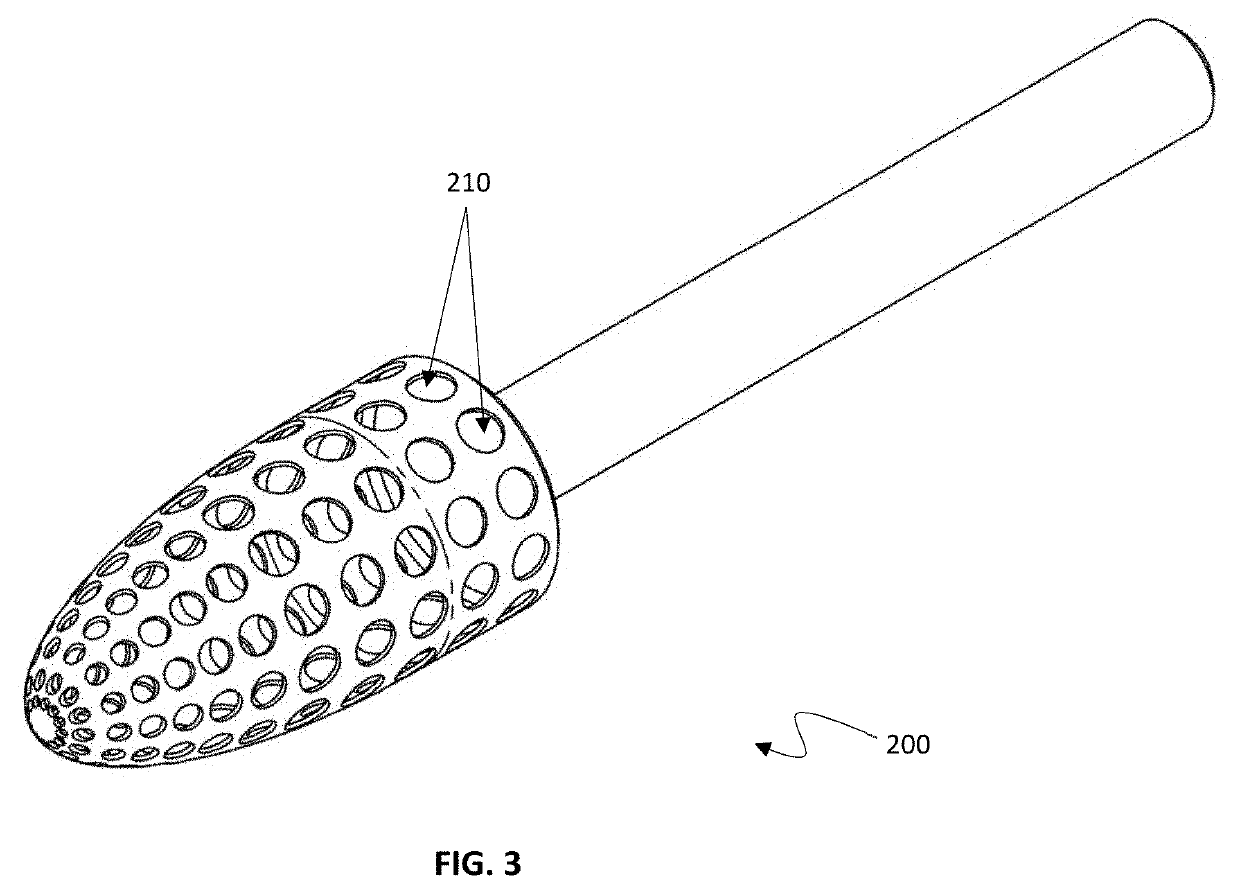Such impedance or prevention of the passage of the bone cells may cause the fusion procedure to fail thereby resulting in a negative
impact on the health of the patient.
One well known complication of
spine fusion surgery is pseudoarthrosis, which can occur when a patient's vertebral segments fail to fuse together in a desired manner, often leading to
back pain,
instability, and need for further surgery.
Even if a given fusion procedure is successful, the process may take a year or more for completion, and during this time (or for varying periods afterwards) the patient often experiences
resultant pain and disability.
There are many expensive methods, devices, biologics, and allografts currently commercially available that claim to improve the rate and / or quality of fusion in a surgical procedure.
This type of bone preparation and cleaning can be a tedious and time-consuming process.
In many cases, the current bone cleaning process is often, tedious, difficult, incomplete, and / or
time consuming resulting in (1) incomplete or inadequate bone graft preparation that may lead to delayed and inadequate fusion or healing, (2) incomplete or inadequate bone
bed preparation that may lead to delayed and inadequate fusion or healing, (3) the use of undesirable bone graft, especially where it incorporates and / or is utilized with attached small tissue, (4) the discarding of good
bone stock because it is difficult or impossible to separate from associated
soft tissue, (5) an increase in the occurrence of pseudoarthrosis, or (6) failure of the surgical procedure.
The tools that are typically used can include general multi-purpose tools that may be designed for proper
bone removal, but are not intended and / or well suited to remove
soft tissue.
For example, currently used
drill bits and burrs could be used to clean bone, but these are designed to
cut, ream, or
grind away bone, and are not typically intended to remove soft tissues while maintaining optimal fusion bone yield.
Using generalized multi-purpose tools to prepare and remove the autograft can yield a wide variety of disadvantages, including (1) low autograft bone yield, (2) disposal of bone autograft because the bone graft may be too strongly attached to
connective tissue for adequate or timely removal for the operation, (3) poor tool strength and material / bone build-up because it may not be used for its intended purpose, (4) multiple tool exchanges (and additional time for the surgeon) be may be required to accomplish preparation of a given anatomical structure of the patient, (5) loss and / or
contamination of useable
bone material where tool linkages, lubricants and / or coolants prevent collection and utilization of removed material, (6) difficulty in collecting removed
bone material from
cutting surfaces and / or tool voids, and / or (7) loss of bone from mishandling during the course of cleaning the bone.
While some such instruments have been used to remove soft tissue and shape bone, each is functionally limited in providing an effective means to remove soft tissue from bone.
However, to remove soft tissue from bone, bone burrs require significant force and high speed rotation of the burr.
Such heat increases the potential for the onset of thermal
necrosis.
Additionally, such prior art devices commonly require the application of water during its use to reduce the heat build-up.
The use of water can significantly decrease the
visibility within the operative area and thereby creates a potential surgical problem.
Though the saw blade can effectively
cut bone, it is ineffective and impractical to use a saw blade to remove
layers of soft tissue from bone, as the saw is typically unable to differentiate between the types of tissue(s) it is
cutting.
Attempts at such removal generally resulted in loss of
bone stock and very little removal of the soft tissue.
Further, the use of saw blades does not provide a means to easily contour round bone or bone grafts.
Such use however, requires that the jaws of the device bite into the bone itself and thereby typically remove
bone material in the process of removing soft tissue.
The use of such a device is both
time consuming and ineffective when small autograft or allograft are being used, and it is difficult to follow the contours or curved surfaces with rongeurs.
However, this device creates a significant amount of heat at the contact point of the cautery tip on the bone.
Prior art devices used to remove soft tissue, decorticate and or shape bone, do not allow sufficient control of the amount of soft tissue removed as compared to the amount of bone removed or the device creates significant heat at the bone / device interface, thereby increasing the potential for a negative clinical result.
While wire-
bristle rotary cutters are disclosed as being capable of separating soft tissue from underlying bone, the wire bristles will often very quickly fatigue and fracture in contact with the underlying
bone surface, potentially ejecting the fractured wire outward in a manner which makes such brushes highly undesirable for use in
surgical procedures.
Moreover, the bristles can also easily remove hard and / or
bony tissues in an indiscriminate manner, which is undesired in many instances.
In addition, the high rotational speed of wire-
bristle rotary cutters can easily generate excessive heat on the
bone surface, and this rotation further typically renders such devices incapable of retaining any significant amount of morselized tissue and / or bone fragments, as the
centrifugal force generated by such rotation will throw such fragments outward of the wire-
bristle fibers.
 Login to View More
Login to View More  Login to View More
Login to View More 


